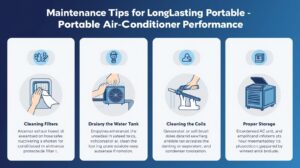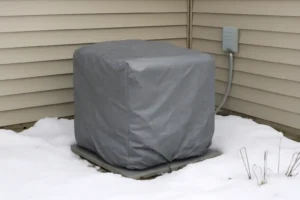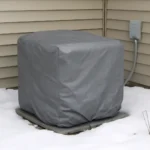As summer heat rises, many of us are looking for ways to stay cool and comfortable indoors. Portable air conditioners offer a flexible, cost effective solution without the need for permanent installation. These compact units can cool down your space efficiently and are easy to move from room to room.
But how exactly do portable air conditioners work? In this guide, we’ll break down the cooling process, explain the components of portable ACs, and offer expert installation and maintenance services, and choosing the right unit for your needs.
Understanding the Cooling Process
The cooling process in a portable air conditioner may sound complex, but it’s actually based on simple principles of heat exchange. Just like other air conditioning systems, portable air conditioners rely on evaporative cooling to absorb and remove heat from a room. Here’s a step by step breakdown:
-
Air Intake: A portable AC pulls warm air from the room into the unit via a fan. This air is often humid and carries excess moisture.
-
Cooling Mechanism: The warm air then passes over the evaporator coils, which are filled with refrigerant. The refrigerant absorbs the heat, causing the air to cool down. As the air cools, it also loses some of its moisture, reducing the humidity in the room.
-
Heat Transfer: The heated refrigerant then moves to the compressor, where it is pressurized and transformed into a gas. This high pressure gas travels through the condenser coils, where it releases the absorbed heat into the outside air.
- Expelling Hot Air: The hot air is vented outside through an exhaust hose, which is typically directed through a window. The refrigerant is then cycled back to the evaporator coils, and the process repeats until the desired temperature is reached in the room.
-
Cool Air Circulation: Finally, the cooled air is circulated back into the room, maintaining a comfortable indoor temperature.
This process continues until the room reaches the temperature set on the thermostat of the portable AC, keeping you cool even on the hottest days.
Components That Make Portable AC Unit Work
A portable air conditioner is made up of several key components that work together to cool and dehumidify the air. Let’s look at each one:
- Evaporator Coils: These coils are responsible for cooling the warm air as it passes through. The refrigerant inside the coils absorbs heat from the air, causing it to cool.
-
Compressor: The compressor increases the pressure of the refrigerant, which helps release heat from the air and transform the refrigerant back into a gas.
-
Condenser Coils: After the refrigerant is pressurized, it moves to the condenser coils, where it releases heat to the outside air.
-
Fan: The fan helps circulate the air inside the room, making sure the cool air reaches every corner.
-
Thermostat: The thermostat monitors the room’s temperature and adjusts the cooling process to maintain your desired comfort level.
-
Exhaust Hose: This hose is crucial for venting the hot air out of the room. It’s typically connected to a window for easy air expulsion.
Single Hose vs Dual Hose Portable ACs
When choosing a portable air conditioner, you’ll encounter two primary types: single hose and dual hose models. For professional installation and expert advice, check our complete AC installtion services. While both are effective in cooling rooms, they work slightly differently and offer various advantages depending on your space and needs.

Single Hose Portable ACs
Single hose models are the most common and tend to be more affordable. These units use one hose to both intake warm air and expel the heated air. Here’s how it works:
- The unit pulls warm air into the unit, cools it, and then expels the hot air and moisture outside through the same hose.
-
However, the use of a single hose can create negative air pressure in the room, which means that hot air from adjacent rooms or the outside may be drawn in, making the cooling process less efficient.
These models are great for smaller spaces and can be easier to set up. However, they may require more frequent maintenance, as they tend to work harder to keep the room cool.
Dual Hose Portable ACs
Dual hose models are more efficient and are ideal for larger spaces or hotter climates. These units use two separate hoses one for intake and one for exhaust:
- The intake hose pulls in fresh air from outside to help cool the unit’s compressor and prevent overheating.
-
The exhaust hose expels the warm air and moisture from the room to the outside.
By using two hoses, dual hose models don’t create negative pressure in the room, making them more energy efficient and effective at cooling larger spaces. These units are typically a bit more expensive and may require more installation effort, but they are often a better option for bigger rooms or areas with high temperatures. Airease our trusted portable AC brand offers reliable, efficient models to meet your cooling needs.
Key Features to Look For
When selecting a portable air conditioner, there are several features that can enhance your experience and help you maintain a comfortable temperature. Here are some of the most common features to look for:
-
Adjustable Thermostat: This feature allows you to set a specific temperature for your room. The air conditioner will automatically adjust its cooling output to maintain the desired level of comfort.
-
Multiple Cooling Speeds: Portable ACs often offer several cooling speeds, allowing you to choose a lower speed for quieter operation or a higher speed for faster cooling.
-
Dehumidifier Function: Many portable air conditioners come with a dehumidifying feature that helps reduce humidity levels in the room, making it more comfortable and less prone to mold and mildew growth.
-
Timer: Some models allow you to set a timer for the AC to turn on or off at a specific time. This can be handy if you want to cool the room before you arrive home or turn off the unit while you’re sleeping.
-
Air Filtration System: Built in air filters can trap dust, pollen, and other airborne particles, improving indoor air quality.
-
Portability: Many models come with built in wheels for easy movement from room to room. This makes them ideal for renters or people who need to cool multiple spaces.
Maintenance Tips for Long Lasting Performance

To ensure your portable air conditioner runs efficiently and lasts for years, it’s important to perform regular maintenance. Here are some essential maintenance tips:
- Clean or Replace Filters Regularly: The filters trap dust and allergens, so cleaning them every two weeks or as recommended by the manufacturer is crucial for maintaining airflow and efficiency.
-
Check the Exhaust Hose: Make sure the hose is not kinked or blocked. Any obstruction can reduce airflow and make the unit less effective. Clean it regularly to ensure optimal performance.
-
Drain the Condensate Tank: Some models collect moisture in a tank that needs to be emptied regularly. Be sure to check and drain the tank to prevent overflow and water damage.
-
Clean the Coils: Dust and dirt can accumulate on the evaporator and condenser coils, which can reduce the unit’s efficiency. Clean the coils periodically using a soft brush or a vacuum with a brush attachment.
- Store the Unit Properly: When not in use, store your portable air conditioner in a cool, dry place. This helps prevent dust buildup and protects the sensitive components from damage.
Can You Use a Portable AC Without a Window?
Many people wonder if portable air conditioners can function without a window. The short answer is yes, but it requires some creativity with the venting. While a window is the most common and simplest way to expel hot air, it’s possible to vent a portable AC through: Professional AC installation experts can help you set up the best venting solutions for your space.
-
Drop Ceilings: If you have a drop ceiling in your room, you can vent the air through this opening.
- Wall Venting: In cases where a window isn’t available, you can cut a hole in the wall and install a venting system.
-
Dryer Vents: If there’s an existing dryer vent in your room, you may be able to connect the exhaust hose to it.
The key is to ensure that the hot air has a place to escape from the room. Without venting, the unit will struggle to remove heat, causing the room to remain warm and reducing the unit’s efficiency.
Pros and Cons of Portable Air Conditioners
Pros
-
Portable and Versatile: You can move them from room to room, making them ideal for renters or people with multiple rooms that need cooling.
-
Easy Installation: No need for professional installation; most models come with everything you need for quick setup.
-
Space Saving: These units don’t take up much space and can be tucked away when not in use.

Cons
- Noise Levels: Portable air conditioners tend to be noisier than their traditional counterparts, which can be a concern in quiet environments.
- Energy Efficiency: They tend to consume more energy than central AC systems or window units, which can result in higher electricity bills.
- Limited Cooling Capacity: While great for small to medium sized rooms, they may struggle to cool larger spaces effectively.
Final Thoughts
Portable air conditioners are a convenient and efficient cooling solution for spaces where traditional air conditioning systems aren’t feasible. By understanding how they work, the differences between single hose and dual hose systems, and how to maintain your unit properly, you can ensure a comfortable and cool indoor environment. Contact Hansons for expert installation and maintenance services to keep your portable air conditioner running smoothly. Whether you’re cooling a small apartment, a room with no window, or a temporary space like an RV, portable air conditioners are a flexible and effective option.












